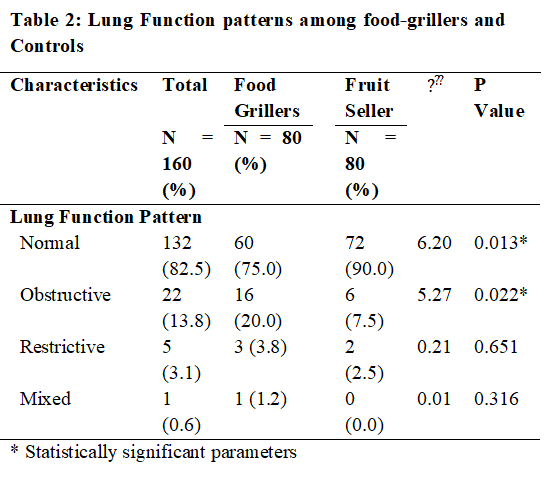Spirometric Indices of Charcoal Smoke Exposed Food Grillers in Yenagoa South-South, Nigeria
Clinical Medicine And Health Research Journal,
Vol. 2 No. 5 (2022),
29 September 2022
,
Page 226-233
https://doi.org/10.18535/cmhrj.v2i5.91
Abstract
Background: Pulmonary function is an important marker of the effects of air pollution on the exposed population. Mild to moderate reductions of FEV1/FVC, FEV1, FEV1%, PEF, and FEF25–75 have been associated with the exposure to biomass burning in cross-sectional studies. Some hospital-based case-control studies, confirm that people exposed to biomass smoke have high risk for developing airflow obstruction with significant reduction of FEV1 and FEV1/FVC.
However, none of these studies has evaluated lung function parameters among charcoal smoke exposed food grillers.
Therefore this index study took a look at spirometric indices among food grillers exposed to charcoal smoke in Yenagoa, South-South Nigeria.
Methods: This was a comparative observational cross-sectional study of charcoal smoke exposed spirometric indices of food grillers compared to fruit sellers The Medical Research Council (MRC) Questionnaire was administered to participants and a “one-on-one” interview was conducted by the researcher using the questionnaires.Information obtained included socio-demographic characteristics such as age, gender, marital status and level of education. Spirometry was performed in accordance with the ATS/ERS using standard single reusable turbine spirometer (MIR Spirobank II Basic; manufactured by P & A Medical Limited). Spirograms that met the ATS/ERS criteria for acceptability were used. Information obtained with the spirometer were FEV1, FVC, FEV1/FVC, PEF and FEF25-75. A portable HANA analogue weight machine was used to weigh the study participants and a flexible plastic tape measure was used to measure the heights of participants
Results: A total of one hundred and sixty (160) participants made up of eighty (80) food-grillers and fruit-sellers (controls) respectively were recruited for this study. A normal lung function pattern was found in 60 (75.0%) of food-grillers and 72 (90.0%) of controls. This shows that more fruit-sellers had normal lung function pattern, and this was statistically significant (p = 0.013). Obstructive pattern was found in 16 (20.0%) of food-grillers and 6 (7.5%) of controls (p = 0.022).
The mean lung function values for food-grillers compared to fruit sellers were: FEV1=2.8±0.5L vs 3.2±0.5 (72.3±5.8% predicted); FVC=3.6±0.6L vs 3.9±0.8 (76.8±6.6% predicted), FEV1/FVC=78.5±4.9 vs 85.3 ±5.3 (77.1±5.4% predicted); PEF=5.7± 1.2L/s vs 6.9 ±2.9 (81.6±7.3% predicted) and FEF25-75=2.8±0.8L/s vs 3.0 (±0.4) (80.5±15.3% predicted). The values were statistically different between food-grillers and controls (p < 0.001).
Conclusion:
- Exposure to charcoal smoke is associated with the development of lung function abnormalities and reduction in lung function parameters.
- Increasing exposure time to charcoal smoke increase the likelihood of lung function abnormalities.
- Spirometric indices, food grillers, charcoal smoke.

How to Cite
Download Citation
References
- Article Viewed: 0 Total Download


